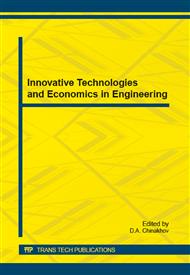p.21
p.25
p.32
p.35
p.41
p.46
p.53
p.58
p.64
Formation of Fine Structure of Differentially Hardened Rails
Abstract:
Differential hardening of rails by compressed air at different regimes is accompanied by formation of morphologically different structure, being formed according to the diffusion mechanism of γ ↔ α transformation and consisting of grains of lamellar pearlite, free ferrite and grains of ferrite-carbide mixture.By methods of transmission electron microscopy the layer by layer analysis of differentially hardened rails has been carried out, the quantitative parameters of the structure, phase composition and dislocation substructure have been established and their comparison has been made for different regimes of hardening. It has been found that the structure-phase states being formed have gradient character, defined by the hardening regime, direction of study from the tread contact surface and by depth of location of layer under study.
Info:
Periodical:
Pages:
41-45
Citation:
Online since:
October 2014
Authors:
Keywords:
Price:
Сopyright:
© 2014 Trans Tech Publications Ltd. All Rights Reserved
Share:
Citation:


